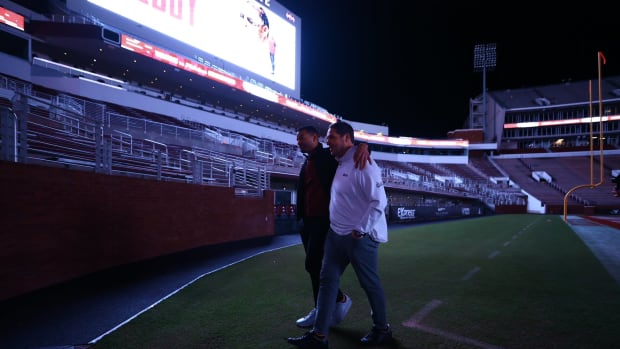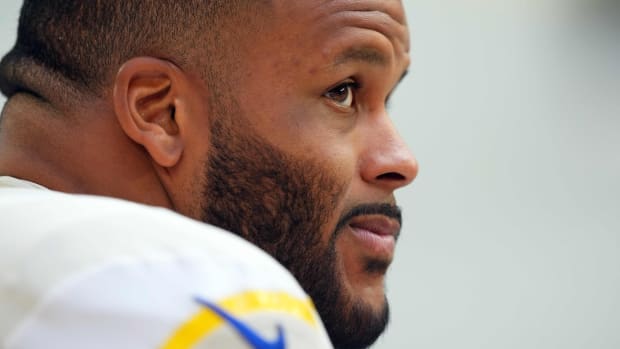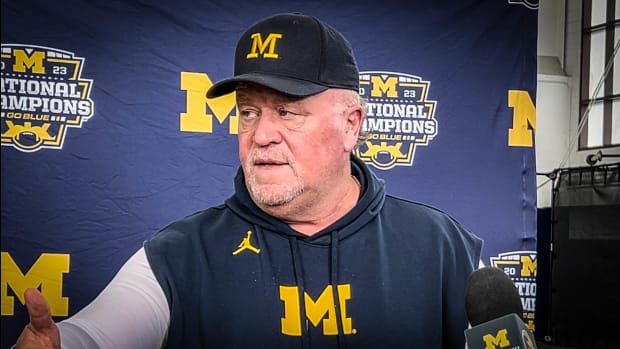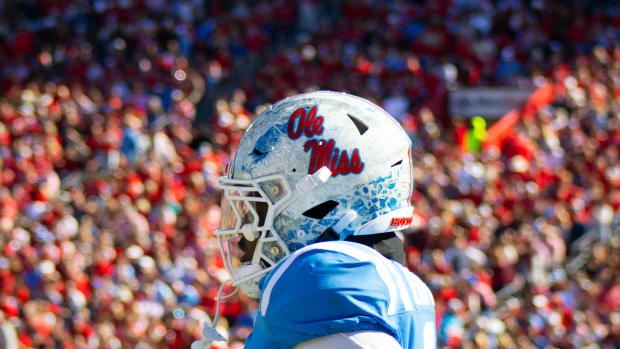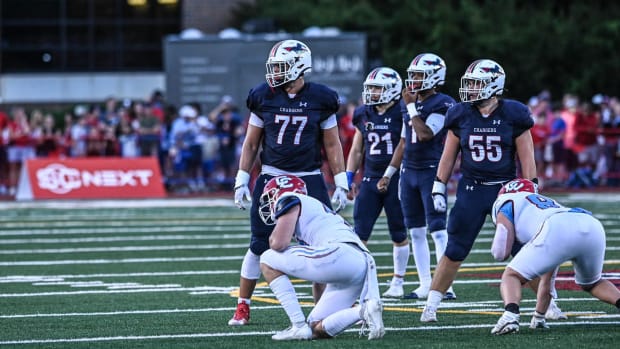How Do the Findings of Jordan McNair Investigation Impact Pending Lawsuit, Durkin's Future?
In a move that poses significant legal implications, the University System of Maryland’s Board of Regents on Friday released findings from a university-commissioned investigation into the heatstroke-related death of offensive lineman Jordan McNair. The 6-foot-5, 325-pound redshirt freshman, who had played high school football at the McDonough School in Owings Mills, Md., died on June 13. The death occurred two weeks after McNair had become ill while running sprints during a team practice held in 80-degree weather. Despite exhibiting multiple symptoms consistent with heatstroke, it would be an hour and seven minutes before Maryland training staff called 911 and an additional half hour before McNair was admitted into a local hospital. The investigation into McNair’s death was led by Dr. Rod Walters, a well-known expert on athletic training. A separate investigation into the “toxic coaching culture” of Maryland football, led by a four-person commission that includes retired federal judges and experienced attorneys, remains ongoing.
You have reached your limit of 4 premium articles
Register your email to get 1 more
The Walters’s report is formally titled, “Independent Evaluation of Procedures and Protocols Related To the June 2018 Death of a University of Maryland Football Student-athlete.” The report is based on over 50 interviews and a review of over 70 documents. As expected, the report places significant blame on university trainers and medical staff. They are portrayed as alternatively abusive and passive about the well-being of a teenager who was in obvious need of urgent medical care.
DJ Durkin Remains on Leave Following Investigation Into Jordan McNair's Death
The report also identifies impactful mistakes that occurred at different points in the timeline of events on May 29. For example, Walters describes a “complacency of the perceived workout intensity.” He also observes a faulty “assumption of the mildness of the weather” conditions that were present during the sprints. Walters stresses that while these oversights may not necessarily seem predictive of a young man dying, they took on greater significance with the 325-pound McNair. He suffered from a Vitamin D deficiency and was on a prescription of a stimulant medication used to treat Attention-Deficit/Hyperactivity Disorder (ADHD). Walters points outs that stimulants can increase the risk for heatstroke and that “there is general concern among the medical community for student-athletes involved in physical activity while taking stimulant medication.”
One particularly chilling portion of Walters’s report is a recounting of an interview with a student-athlete. This student-athlete is presumably one of McNair’s teammates and, more importantly, was an eyewitness to the practice when McNair became ill. The student-athlete recalled how head football athletic trainer Wes Robinson “yelled at the interns to drag [McNair] across the field.” This player also recalled how two of the interns “were intertwined with [McNair’s] legs trying to hold him up.” Maryland suspended Robinson last month.
Mistakes would only continue in the crucial minutes that followed McNair exhibiting heatstroke symptoms. One especially egregious error was the failure of the training staff to cool McNair down. Such cooling down, Walters asserts, should have occurred within the first half hour of showing symptoms. Instead, incredulously, “no vital signs were noted.” A person reading Walters’s report might defensibly conclude that the staff didn’t care that much about McNair.
These oversights or blunders not only failed to aid McNair, but they in fact exacerbated his ailments. Like many health conditions, heatstroke is often survivable if appropriate treatment is provided in a timely manner. If untreated, heatstroke can severely damage the heart, kidneys and other organs. The Walters’s report confirms that about an hour passed before Maryland trainers called 911 and that important protocols and procedures were ignored or bypassed.
Walters also details a lack of urgency on the part of Maryland employees to assist emergency medical services personnel when they arrived on campus. Curiously, no Maryland staff went to escort EMS and help them get to McNair in spite of university protocol to do so. To that end, Walters notes there was a “failure to provide directions to EMS to the scene and designate an individual to flag down EMS and direct to scene . . . there was confusion as EMS arrived in the Gosset parking lot while the target point was the field level driveway as referenced in [university handbook].” One would expect the staff would not only have been there when EMS arrived, but also have aggressively and insistently guide them to McNair in the fastest route possible. likewise vexing, EMS were apparently not alerted about construction on campus. Such construction further delayed EMS from physically getting to McNair.
As offered by Walters, who regards the school’s response as frustratingly slow and ineffective, here is a snapshot of the time duration of key events:
• 34 minutes and 12 seconds: The amount of time that elapsed between the onset of McNair suffering cramps and McNair being removed from field.
• 23 minutes and 55 seconds: The amount of time that elapsed between McNair being treated in the athletic training room and a change in stature.
• Eight minutes and 33 seconds: The amount of time that elapsed between when the 911 call was made and the ambulance arriving in the parking lot.
• 37 minutes and 3 seconds: The amount of time that elapsed between when the 911 call was made and the ambulance departing the stadium.
• One hour and seven minutes: The amount of time that elapsed between when McNair showed symptoms and school officials made the 911 call.
• One hour and 39 minutes: The amount of time that elapsed between the onset of McNair suffering heatstroke symptoms and him arriving at the hospital with a body temperature of 106 degrees.
Walters isn’t uniformly critical of Maryland. He notes, for instance, that the school features an adequate system to address circumstances like the one that befell McNair. Yet in another light such a compliment is more of a condemnation: If there was a decent set of protocols, why weren’t they followed? Taken together, Walters finds that while “hindsight is 20/20” different conduct by Maryland employees “might have changed things.”
A Timeline of Jordan McNair's Death, DJ Durkin's Firing and Its Aftermath
The report provides detail to assertions made in August by University of Maryland president Wallace Loh and athletic director Damon Evans. Loh went so far as to say the school accepts “legal and moral responsibility” for McNair’s death. In doing so he and Evans acknowledged that mistakes and misdiagnoses were made, such as a failure to take McNair’s temperature or place ice on his overheated body. Walters’s report provides more detail and expert corroboration to more general statements by Loh and Evans.
Impact on pending wrongful death and survival action lawsuit
While a settlement between McNair’s family and Maryland remains the most likely conclusion to pending litigation, the family has signaled that it intends to fully utilize the courts in order to hold the school accountable. William “Billy” Murphy of Baltimore law firm Murphy, Falcon & Murphy has formally notified the university of the McNair family’s intent to file a $30 million lawsuit. According to ESPN, each parent—Marty McNair and Tonya Wilson—claims to have suffered at least $10 million in damages as a result of their son’s death and together they contend that their son experienced at least $10 million in his own damages prior to death.
If the family sues, likely defendants would include the university, head coach DJ Durkin, former strength and conditioning coach Rick Court and Robinson. The family might expand any lawsuit to include the NCAA and the Big Ten, as both entities have regulatory oversight over the Terrapins football program. Indeed, the NCAA and the Big Ten’s arguable failure to ensure that a member school provided a safe program could itself be grounds for liability. It is also possible that health care providers, such as the EMTs, physicians and nurses who treated McNair could be sued; whether sued or not, they would be important witnesses in any trial.
A wrongful death claim would be straightforward in design, but complicated in application. The claim would assert that the university (and Durkin et al.) failed to satisfy its duties of care to McNair and that such negligent conduct harmed beneficiaries of the “decedent” (in this context, the parents of McNair are the beneficiaries of their son). The focus of such a claim would be on the reasonableness of the defendants’ conduct. Numerous factors would be considered. They include whether school officials adhered to best practices and industry norms. For instance, the reasonableness of having players run sprints in warm temperature; the wisdom, or lack there-of, of slowly treating players who exhibit heatstroke symptoms; and the lengthy wait involved in contacting emergency services to ensure an athlete receives prompt medical attention would be examined. As part of this analysis, attention would be paid to how Maryland has normally conducted practices and how often the school utilizes standard techniques. If the school deviated from past practices regarding McNair, school officials would need to offer persuasive explanations as to why they did so.
McNair’s parents also plan to seek recovery for the damages—including pain and suffering and mental anguish—suffered by their son prior to his death. A survival action claim contemplates this type of harm and it features a representative of the decedent standing in for him or her (here, McNair’s parents would he “standing in” for their late son to avail his rights in court). Damages would be based on how much harm to McNair occurred between the time of his injury and his death.
The many persons directly or indirectly involved in the care of McNair—including Maryland coaches, staff, EMTs, physicians, nurses etc.—would be likely witnesses in a trial. Expert witnesses would likewise testify as well. Relevant electronic evidence, such as emails, texts and social media posts sent by defendants about their interactions with McNair, would be scrutinized.
Maryland law caps pain and suffering and other non-economic damages for wrongful death and survival action to approximately $2 million, yet the state imposes no such cap on damages for economic loss. As a result, a critical element of a trial would be the extent to which Murphy could prove that McNair would have gone on to earn a great deal of money. Perhaps awkwardly given that McNair was so much more than a football player, part of the trial would concern the likelihood that McNair would have become an NFL player and enjoyed a long and lucrative career. This type of debate would feature expert witnesses, such as retired NFL scouts, who would be hired to project McNair’s path as a football player. The debate would be inherently speculative, particularly given that McNair—a three-star recruit—hadn’t yet played a down in a college game.
To put it mildly, Walters’s damning report, coupled with blunt admissions of fault by Loh and Evans, make it very likely that McNair’s parents would prevail in a trial. Less predictable would be the amount of damages that would be awarded by a jury. As noted above, Maryland’s cap on pain and suffering could play a substantial role in limiting how much money would be awarded to McNair’s parents. In order to secure damages that approximate $30 million, Murphy would need to provide compelling evidence on economic damages.
The odds of a trial happening are actually slim. The university, which reportedly has an endowment of more than $540 million, will make every effort to settle with McNair’s family. Chances are, they’ll eventually reach a settlement with the family. Expect any settlement to include more than a transfer of money. A scholarship in McNair’s name and university donations to organizations that study heatstroke and related afflictions are certainly possible.
Impact on DJ Durkin
Walters’s 74-page report does not mention the name of Terrapins head coach DJ Durkin, who hasn’t coached the team since Aug. 11. It was then when the school placed Durkin on “administrative leave,” which is tantamount to a paid suspension but does not constitute a finding of fault. Since that time, offensive coordinator Matt Canada has served as interim head coach and led the team to a 2–1 record. Meanwhile, the university has separated Durkin from the school until it completes its fact-finding.
The Mess at Maryland Is Another Grim Indictment of College Sports's Institutions
The absence of Durkin’s name from Walters’s report should not be construed as a positive for Durkin. As noted above, Robinson (the head football athletic trainer) is accused of directing interns to “drag” an ill McNair across the field. While an organization chart attached to Walters’s report indicates that Robinson reported to the director of athletic training (Steve Nordwall) and not to Durkin, if Durkin had any formal or informal oversight over Robinson, Robinson’s conduct would reflect poorly on Durkin. Also, the same student-athlete who recalled Robinson issuing an order to drag McNair also expressed that the coaching staff preaches a “no quit” mentality. This kind of culture clearly reflects on Durkin, who is ultimately responsible for setting the culture of the team. Further, a more favorable report might have stressed that Durkin emphasized player safety or took particular interest in McNair’s health. No such narrative was offered in the report.
On the other hand, the report doesn’t directly associate Durkin with any wrongdoing nor link him to McNair’s death. Instead, the report focuses on the failures of training and medical staff in response to McNair exhibiting heatstroke. In addition, an appendix to the report mentions that interviews were conducted with some of Durkin’s assistant coaches. They expressed that they saw nothing unusual on the day when McNair took ill. For instance, the report notes that an interview was conducted on Aug. 1 with McNair’s position coach. That person is presumably Bryan Stinespring, who is the Terrapins’ offensive line coach. This coach “was very impressed with Jordan as a student-athlete” and commented that “it was not excessively hot or humid during the run.” The appendix notes that further interviews were conducted “with all position coaches” on Aug. 12. “None” of them, the report indicates, “saw any seizure activity in Jordan McNair.” Such remarks, Durkin might argue, distance the coaching staff—who report directly to Durkin—from the missteps of the trainers and medical staff—who don’t report to Durkin—that contributed to McNair’s death.
As explained with much great detail in another SI piece, if Maryland ultimately decides to sever ties with Durkin, the school could fire him “without cause”—meaning for no wrongdoing. It would then pay him pay him liquidated damages equal to 65% of the remaining aggregate pay and supplemental income on a contract that is set to expire on Dec. 31, 2021 (this would work out to the school paying Durkin about $5.1 million plus remaining paychecks for 2018). If instead the school concludes Durkin breached his contract, such as for “material misconduct” or a “material act of subordination,” the school would only owe Durkin any annual base salary, supplemental annual income, or potential compensation, which accrue prior to the date of termination. While it’s unclear exactly how much money would fall under this category, it would be far less than $5.1 million. It remains to be seen if Walters’s report, which is deeply critical about certain aspects of Maryland’s football program and at least implicitly reflects poorly on Durkin, substantially advance the school’s chances for firing Durkin with cause. If the school takes that route, expect Durkin to then sue the school for breach of contract. A lawsuit would ensure that the controversy continues for months if not years.
Criminal charges remain unlikely
A report that mentions a university trainer ordering a visibly ill McNair be “dragged” across the field and that details a number of other troubling aspects of how university employees knowingly or recklessly increased health risks for a 19-year-old college freshman might lead one to conclude that crimes were committed. At least in theory, crimes may have occurred. Yet criminal charges rarely arise from athletic activities held in the United States. There are various commentaries that attempt to explain why that is the case. One leading explanation is that courts are concerned about how sports would be impacted if coaching/training techniques could lead to criminal charges. Some have concern that fewer people would be willing to coach and that fewer schools (and their insurance companies) would be comfortable financing a sports program.
Not everyone agrees. In 2009, grand jurors in Kentucky indicted a high school football coach, David Jason Stinson, with reckless homicide and wanton endangerment as a result of the heatstroke-related death of sophomore offensive lineman Max Gilpin. Gilpin had been ordered to run wind sprints in temperatures that exceeded 90 degrees. Prosecutors argued such conditions amounted to unjustifiable risks. Stinson, however, was found not guilty. Trial jurors were uncomfortable linking coaching techniques to a finding of criminal acts.
Even if the aftermath of McNair’s death doesn’t intersect with criminal law, it should include serious discussion about the kinds of practice conditions that ought to be imposed on young persons who play sports.
Michael McCann is SI’s legal analyst. He is also Associate Dean of the University of New Hampshire School of Law and editor and co-author of The Oxford Handbook of American Sports Law and Court Justice: The Inside Story of My Battle Against the NCAA.
